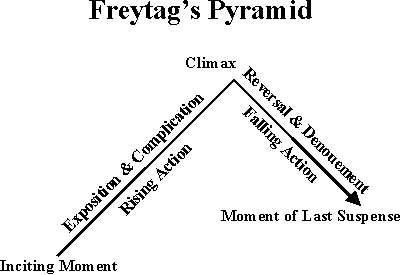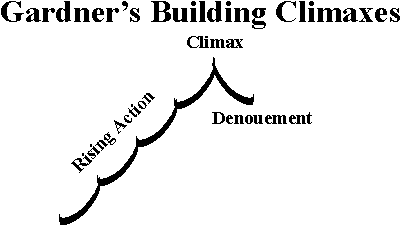
The structure Robert Sweet describes in "Having a Climax" is certainly prevalent in Western stories told in various media and genres, and is as old as the Iliad. Though, I would like to suggest that perhaps this is more a function of our particular culture, that it says more about our consensual beliefs as a people, than an inherent necessity of storytelling.
This structure is derived from Freytag's Pyramid. Gustav Freytag developed a diagrammatic outline of the structure of a five act tragedy in Technik des Dramas [1863]. This proved useful in generally speaking about dramatic structure for tragedy or comedy, for novels, short stories, cinema or television. Roughly, Freytag's Pyramid is organised thus:

Plots laid out specifically to generate such a dramatic high point are by no means a neutral structure. They are suggestive of an outlook that counts life according to these few high points. I remember in secondary school some of my girlfriends believing that a wedding is the happiest day in a woman's life. So if they married in their twenties and lived to their eighties, would that mean that for sixty years they will never achieve any greater happiness ever again? Single climax stories tend to de-emphasise the value of less climactic moments.
This is not to say that historically, and in the lives of various people, that dramatic climaxes do not happen and that they are not of interest. However, full lives are a rich tapestry of meaningful moments as people go through the process of living day to day. Stories can and have satisfactorily represented the process of everyday living, rather than just the high points of living, such as the works of author Garrison Keillor, or almost any comedy serial on television.
Part of the satisfaction of storytelling for digital media is that the media lends itself to stories of process. Part of the frustration for many creators entering into digital storytelling for the first time is that it does not lend itself well to Freytag's Pyramid. The medium is well used when a story is made, at least, interactive in some way. However, the instant an audience is given the power of interactivity, creators lose some of the control over dramatic timing for their climax and so perhaps may lose that climax altogether.
For instance let us say that an audience is moving through a Chandleresque digital mystery story. Unbeknownst to the main character, a private detective, he has been hired by a woman to investigate a murder that she herself committed, in order to validate false evidence against someone else. If the audience discovers her ruse too soon, the plot may become too obvious, and they may lose interest waiting for the moment of confrontation. If the audience discovers her ruse too late, the plot may become confusing and apparently pointless. It is not impossible to create a climax under such circumstances, just very difficult.
With John Gardner's Building Climaxes [Gar84], which further refines Freytag's Pyramid, the audience gets to savour each climax as they lead to an apex. But again with interactivity that crowning moment can become diffused and so have equivalent, though perhaps still conclusive, emotional power to other moments. This is his depiction of climax structure within storytelling:

This new representation takes into account the episodic nature of longer works such as novels, which can have many moments of climax leading up to the peak climactic moment and is more manageable within digital media.
Copyright © 1997 Katherine Phelps